Timeline of excavations at Nimrud
This page gives a brief summary of archaeological work carried out at the site of Nimrud over the past two centuries. For more detail see (1) and Chapters 1–3, 5–12 of (2).
Before excavation | The Victorian era | The early twentieth century | The Cold War era | The Saddam era | The twenty-first century
Before excavation
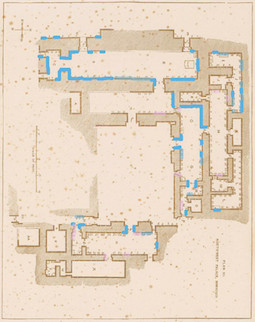
Image 1: Layard's plan of his excavations at the Northwest Palace (3), marked in bright and pale blue to indicate which sculptures had been fully or partially removed by 1850 (4). (Rooms A, J, K, M, O, R, U, V, W, X, Y AA, BB did not contain figural bas-reliefs TT .) View large image.
- 1815
- The Ottoman TT provincial governor TT of Mosul PGP , Ahmed Pasha Jalili PGP , quarries for building stone
- 1816
- James Silk Buckingham PGP visits the site ("Nimrod-Tuppe") on 8 September, noting that it might contain ancient ruins
- 1821
- Claudius James Rich PGP — the East India Company's TT Resident TT in Baghdad PGP — visits the site on 4 March, noticing the remains of the ziggurat and collecting fragments of inscribed bricks TT from the surface
- 1837
- Two brief visits by members of the British expedition TT to chart the Euphrates PGP , on 9 March and 3 June, each noting many fragmentary antiquities on the surface of the mound
- 1844
- British missionary TT Rev George Badger PGP surveys the site in March and proposes its excavation to Sir Stratford Canning PGP ; another missionary, Rev James Fletcher PGP , digs for inscribed bricks
The Victorian era
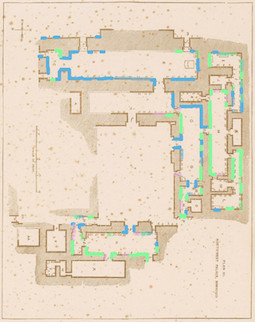
Image 2: Layard's plan of his excavations at the Northwest Palace (5), marked in bright and pale blue and green to indicate which sculptures had been fully or partially removed by 1850 and 1900 respectively (6). (Rooms A, J, K, M, O, R, U, V, W, X, Y AA, BB did not contain figural bas-reliefs.) View large image.
- 1845–47
- Austen Henry Layard PGP excavates parts of the Southwest Palace PGP and the ceremonial areas of king Assurnasirpal II's PGP Northwest Palace, by tunnelling along the edges of walls lined with stone bas-reliefs TT ; his most spectacular finds include the Black Obelisk
- 1849-51
- Layard returns to Nimrud, assisted by Hormuzd Rassam PGP and the artist Frederick Cooper PGP , focusing especially on the ziggurrat and surrounding shrines. Solomon Malan PGP and the Hon. Robert Clive PGP each visit in 1850
- 1852
- Felix Jones PGP maps Nimrud and its surroundings for the East India Company; Rawlinson PGP visits to study the inscriptions that are still in situ
- 1852-53
- Rassam digs mostly at Nineveh PGP but also at Nimrud and Sherif Khan PGP (ancient Tarbiṣu PGP )
- 1854–55
- William Kennett Loftus PGP , with artist William Boutcher PGP , dig on behalf of the British Museum TT and the private Assyrian Excavation Fund TT , at the "Southeast Palace", i.e., the Burnt Palace PGP and Nabu's temple, and probably also at king Tiglath-pileser III's PGP Central Palace PGP ; they find many ivories
- 1860-61; 1864
- Julius Weber PGP , a Swiss entrepreneur, visits Nimrud to acquire reliefs
- 1862
- Henri-Pacifique Delaporte PGP , the French consul TT at Baghdad, vists Nimrud and sends reliefs to the Louvre TT
- 1873
- George Smith PGP excavates briefly on behalf of The Daily Telegraph TT and the British Museum
- 1878
- Rassam returns to Nimrud, commissioning photographs too
The early twentieth century
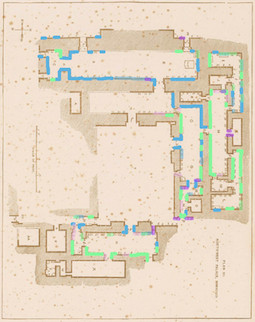
Image 3: Layard's plan of his excavations at the Northwest Palace (7), marked in bright and pale blue, green and purple to indicate which sculptures had been fully or partially removed by 1850, 1900 and 1950 respectively (8). (Rooms A, J, K, M, O, R, U, V, W, X, Y AA, BB did not contain figural bas-reliefs.) View large image.
- 1906
- Walter Andrae PGP , a German archaeologist excavating at Assur PGP , visits and photographs Nimrud
- 1909
- The archaeologist and explorer Gertrude Bell PGP visits Nimrud, taking photographs
- 1926
- British archaeologists, including Max Mallowan PGP , visit Nimrud from Reginald Campbell Thompson's PGP excavations at Nineveh PGP
The Cold War era
- 1949–53
- Max Mallowan directs large-scale excavations on the citadel TT for BSAI TT , first extending the plan of the Northwest Palace, then working on the Governor's Palace, the citadel walls and associated housing, and the Burnt Palace PGP
- 1956-59
- Behnam Abu es-Soof PGP directs excavation and restoration TT work on the Northwest Palace
- 1955-56
- Mallowan resumes excavations for BSAI, at Nabu's temple, and Ninurta's temple and its ziggurat, and begins work on Fort Shalmaneser
- 1958-62
- David Oates PGP directs BSAI's excavations at Fort Shalmaneser, replaced by Jeffrey Orchard PGP in 1963
- 1969-77
- Said al-Iraqi PGP and Hazim Abd el-Hamid PGP re-excavate and restore much of the Northwest Palace for the Iraqi Department of Antiquities, including excavation of many ivories from the Well in courtyard AJ
- 1974-76
- Janusz Meuszyński PGP directs Polish archaeological work at the Northwest Palace and the central part of the royal citadel
The Saddam and post-Saddam era
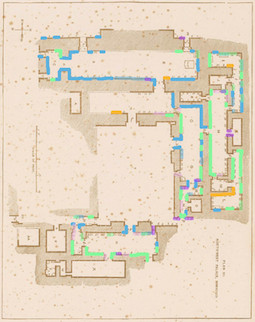
Image 4: Layard's plan of his excavations at the Northwest Palace (9), marked in bright and pale blue, green, purple and yellow to indicate which sculptures had been fully or partially removed by 1850, 1900, 1950 and 2000 respectively (10). (Rooms A, J, K, M, O, R, U, V, W, X, Y AA, BB did not contain figural bas-reliefs.) View large image.
- 1985-92
- Muzahim Mahmoud Hussain PGP re-excavates and restores Nabu's temple and further areas of the Northwest Palace, for the State Board of Antiquities and Heritage TT (SBAH), finding the famous queens' TT tombs in 1988 and Well 4 in 1992
- 1987-89
- Paolo Fiorina PGP leads Italian excavation work in Fort Shalmaneser and the nearby city walls
- 1989
- John Curtis directs small-scale excavations at Fort Shalmaneser for the British Museum
- 1990
- International projects at Nimrud are stopped in the run-up to the Gulf War TT
- 2001
- Muzahim Mahmoud Hussain re-excavates Ištar's temple for the SBAH
- 2002
- The BSAI and British Museum hold a large conference to re-evaluate the archaeology of Nimrud (11)
The twenty-first century
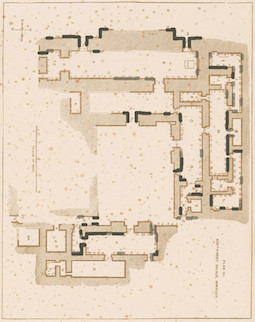
Image 5: Layard's plan of his excavations at the Northwest Palace (12), marked in black and grey to indicate where complete or partial sculptures were still in situ before the destruction of the palace in early 2015 (13). (Rooms A, J, K, M, O, R, U, V, W, X, Y AA, BB did not contain figural bas-reliefs.) View large image.
- Spring 2003
- Iraq War TT ; Nimrud remains safe from post-war looting
- Summer 2014
- ISIS TT invades northern Iraq, including Nineveh province TT in which Nimrud is situated
- Spring 2015
- ISIS releases a propaganda video which shows the destruction of Northwest Palace; the status of the rest of the site is currently unknown
Content last modified: 18 Dec 2019
References
- Postgate, J.N. and J.E. Reade, 1976-1980. "Kalhu", Reallexikon der Assyriologie und Vorderasiatischen Archäologie 5, Berlin: Walter de Gruyter, pp. 303-323. (Find in text ^)
- Curtis, J., H. McCall, D. Collon and L. al-Gailani Werr (eds.), 2008. New Light on Nimrud: Proceedings of the Nimrud Conference 11th-13th March 2002, London: British Institute for the Study of Iraq (free PDF from BISI, 22 MB). (Find in text ^)
- Layard, A.H., 1849-1853. The Monuments of Nineveh: From Drawings Made on the Spot, vols. I–II, London: John Murray (free online edition of vol. 1 and vol. 2), pp. I plate 99 plan III. (Find in text ^)
- Englund, K., 2003. Nimrud und seine Funde: Der Weg der Reliefs in die Museen und Sammlungen (Orient-Archäologie 12), Rahden: Verlag Marie Leidorf, pp. 43-160. (Find in text ^)
- Layard, A.H., 1849-1853. The Monuments of Nineveh: From Drawings Made on the Spot, vols. I–II, London: John Murray (free online edition of vol. 1 and vol. 2), pp. I plate 99 plan III. (Find in text ^)
- Englund, K., 2003. Nimrud und seine Funde: Der Weg der Reliefs in die Museen und Sammlungen (Orient-Archäologie 12), Rahden: Verlag Marie Leidorf, pp. 43-160. (Find in text ^)
- Layard, A.H., 1849-1853. The Monuments of Nineveh: From Drawings Made on the Spot, vols. I–II, London: John Murray (free online edition of vol. 1 and vol. 2), pp. I plate 99 plan III. (Find in text ^)
- Englund, K., 2003. Nimrud und seine Funde: Der Weg der Reliefs in die Museen und Sammlungen (Orient-Archäologie 12), Rahden: Verlag Marie Leidorf, pp. 43-160. (Find in text ^)
- Layard, A.H., 1849-1853. The Monuments of Nineveh: From Drawings Made on the Spot, vols. I–II, London: John Murray (free online edition of vol. 1 and vol. 2), pp. I plate 99 plan III. (Find in text ^)
- Englund, K., 2003. Nimrud und seine Funde: Der Weg der Reliefs in die Museen und Sammlungen (Orient-Archäologie 12), Rahden: Verlag Marie Leidorf, pp. 43-160. (Find in text ^)
- Curtis, J., H. McCall, D. Collon and L. al-Gailani Werr (eds.), 2008. New Light on Nimrud: Proceedings of the Nimrud Conference 11th-13th March 2002, London: British Institute for the Study of Iraq (free PDF from BISI, 22 MB). (Find in text ^)
- Layard, A.H., 1849-1853. The Monuments of Nineveh: From Drawings Made on the Spot, vols. I–II, London: John Murray (free online edition of vol. 1 and vol. 2), pp. I plate 99 plan III. (Find in text ^)
- Englund, K., 2003. Nimrud und seine Funde: Der Weg der Reliefs in die Museen und Sammlungen (Orient-Archäologie 12), Rahden: Verlag Marie Leidorf, pp. 43-160. (Find in text ^)